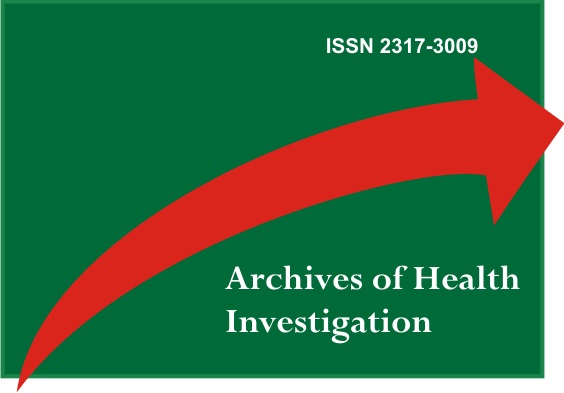Prevalence and associated factors of sexual dysfunction in women after mastectomy: a cross-sectional study
DOI:
https://doi.org/10.21270/archi.v10i5.5278Keywords:
Breast Cancer, Women's Health, Health PromotionAbstract
Breast cancer is one of the most common tumors among women, causing cardiovascular, motor and sexual disorders. The objective of the study was to identify the prevalence of sexual dysfunction in mastectomized women and to analyze the correlation between the domains of sexual response in the phases of female sexual response. This is a cross-sectional study with 54 women who underwent mastectomy surgery aged 30 to 59 years. To evaluate sexual dysfunction, the Female Sexual Function Index instrument was used. It was possible to verify that the prevalence of sexual dysfunction among mastectomized women was 77.7%. The phases of sexual response that were significantly affected were: arousal (r = 0.86), lubrication (r = 0.80), orgasm (r = 0.86), satisfaction (r = 0.81), pain (r = 0.80) and the first phase of the sexual response, which is desire (r = 0.41), presented a moderate correlation. Regarding sexual performance, no woman had an excellent performance, only 12 had a good result and 42 had a bad result. There was a high prevalence of sexual dysfunction among mastectomized women, with changes in aspects related to arousal, lubrication, orgasm, satisfaction and pain. We suggest, therefore, that further studies addressing this theme should be carried out, to elucidate the relationship between the domains of sexual response and sexual dysfunction in women undergoing mastectomy. The importance of promoting health promotion strategies, actions and interventions for mastectomized women in the context of interdisciplinarity is evident.
Downloads
References
Bastianello MR, Hutz CS. Otimismo e suporte social em mulheres com câncer de mama: uma revisão sistemática. Psicol Teor Prat. 2016;18(2):19-33.
Ministério da Saúde; Instituto Nacional de Câncer- INCA.Biblioteca On-Line. Acesso em: 11 dez. 2010. Disponível em: https://www.inca.gov.br/controle-do-cancer-de-mama/conceito-e-magnitude
Fagundes, MKV Vaccaro MM. Mastectomia radical e sua influência sobre a vivência da sexualidade feminina. Uningá Review. 2016; 25(1):79-86.
Cesnik VM, Santos MA. Mastectomia e sexualidade: uma revisão integrativa. Psicologia: Reflex Crit. 2012;25(2):339-49.
Almeida TRD, Guerra MR, Filgueiras MST. Repercussões do câncer de mama na imagem corporal da mulher: uma revisão sistemática. Physis. 2012;22(3):1003-29.
Auwad WA, Hagi SK. Female sexual dysfunction: what Arab gynecologists think and know. Int Urogynecol J. 2012;23(1):919-27.
Santos DBS, Santos MA, Vieira EM. Sexualidade e câncer de mama: Uma revisão sistemática da literatura. Saúde Soc. 2014;23(4):1342-55.
Raposo JV, Moreira TL, Arbinaga F, Teixeira CM. Satisfação sexual em pacientes com câncer. Acta Colomb Psicol. 2017;20(2):84-94.
Macedo JB, Brondani AS, Costa GS, Messias BES, Nardi LLD, Braz MM. Occurrence of sexual dysfunctions in mastectomized females with or without breast reconstruction. Acta Scientiarum. 2018;40(1):e34544.
Antunes MD, Nishida FS. Morbidade hospitalar em idosos do paraná durante o ano de 2016. Encicl Biosf. 2017;14(26):1166-74.
Pacagnella RDC, Vieira EM, Rodrigues JOM, Souza CD. Adaptação transcultural do female sexual function index. Cad Saúde Pública. 2008;24(2):416-26.
Canário ACG, Paiva LC, Florêncio GLD, Melo CMLN, Gonçalves AK. Prevalência de disfunção sexual em mulheres sobreviventes de câncer de mama. Anais CIEH. 2015;2(1):1-7.
Sreelakshmy K, Velayudhan R, Kuriakose D, Nair R. Sexual dysfunction in females with depression: a cross- sectional study. Trends Psychiatry Psychother. 2017;39(2):106-9.
Pegorare ABGS, Silveira KR, No Ana PS, Barbosa SRM. Assessment of female sexual function and quality of life among breast cancer survivors who underwent hormone therapy. Mastology. 2017;27(3):237-44.
Siegel R, DeSantis C, Virgo K, Stein K, Mariotto A, Smith T et al. Cancer treatment and survivorship statistics, 2012. CA Cancer J Clin. 2012;62(4):220-41.
Souza ACS. Antidepressivos e disfunções sexuais. Rev Psychiatrv. 2017;17(8):1-10.
Siegel R, DeSantis C, Virgo K, Stein K, Mariotto A, Smith T et al. Cancer treatment and survivorship statistics, 2012. CA Cancer J Clin. 2012;62(4):220-41.
Araújo, A. C. G. C.; Nascimento, C. M. L.; Neto, P. F. A.; Silva,B. R. C.; Araújo, K. Q. M. A.; Gonçalves, A. K. Prevalência de disfunção sexual em mulheres sobreviventes de câncer de mama. Top Cienc Saude. 2019;11(1):107-16.
Berghmans B. Physiotherapy for pelvic pain and female sexual dysfunction: an untapped resource. Inter Urogynecol J. 2018;29(1):631-38.


